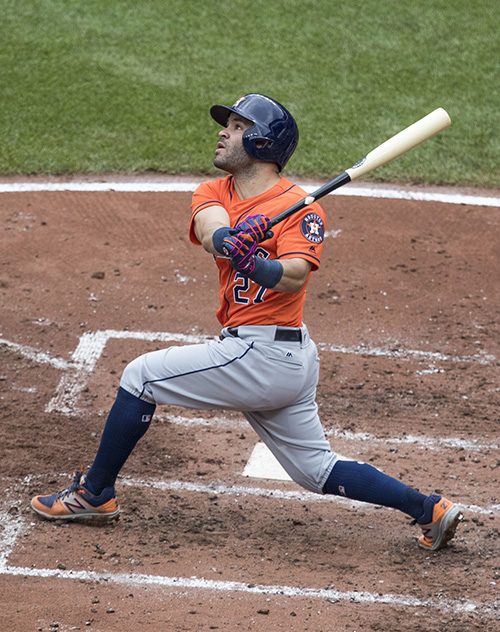 Baseball is the only game left for people. To play basketball, you have to be 7 feet 6 inches. To play football, you have to be the same width. – Bill Veeck, 1975
Baseball is the only game left for people. To play basketball, you have to be 7 feet 6 inches. To play football, you have to be the same width. – Bill Veeck, 1975
While the late Hall of Famer was exaggerating just a bit with the comment above, former MLB owner and team president Bill Veeck was on to something. The game of baseball continues to evolve in many aspects, including the size of the average MLB player.
Bill Petti of SB Nation put together a fantastic study, in which he observed that major league players held height advantage of 5-6% over other US males every decade since 1960. “What’s interesting is that the gap between the average major league and US male weight-wise has shrunk dramatically since 1960,” Petti added, “all the way from a 12% difference to just a tad over 2%.”
Petti’s findings suggest that while scouts and team owners have explored the “bigger is better” concept in baseball, it hasn’t paid dividends. A quick study of current MLB rosters will show that the average height of big teams ranges between 6'-0" and 6'-2".
Considering that the average height of males in the United States and Dominican Republic (countries that represented more than 80% of MLB rosters on Opening Day 2013) is between 5-10 and 5-10 ½, there are many major league players that go unnoticed in our everyday lives.
FOX Sports observed that during the Little League World Series Regionals, two Michigan teams ran out starters that could have easily filled out major league uniforms. Grant Holman and Chad Lorkowski stood at 6-4, 216 pounds and 6-3, 219 (respectively) when they toed the rubber for their teams. Both hurlers were taller than fourteen MLB starters on that day, and even outweighed six of them.
Possibly the most telling comparison out there when discussing size in baseball is how current MLB players stack up to our baseball heroes of yesterday. While today’s player is considerably heavier and assumedly (and hopefully naturally) stronger, there are many current big leaguers that fill out a uniform just like the legends of the past (check out our cover for some visual comparisons):
- Babe Ruth, listed at 6'-2", 215 pounds in his prime, is the same size as current Dodger Carl Crawford
- Cy Young and current Red Sox pitcher Ryan Dempster (6'-2", 210 lbs)
- Johnny Bench and current Indians shortstop Asdrubal Cabrera (6'-1", 210 lbs)
- Walter “the Train” Johnson and Reds pitcher Sam LeCure (6'-1", 200 lbs)
- Bob Gibson and Jake Peavy (6'-1", 195 lbs)
- Mickey Mantle and fellow switch-hitting outfielder Shin-Soo Choo (5'-11", 195 lbs)
- Satchel Paige and Royals pitcher Aaron Crow (6'-3", 180 lbs)
- Willie Mays and Tigers infielder Jose Iglesias (5'-11", 180 lbs)
- Hammerin’ Hank Aaron and Marlins infielder Adeiny Hechavarria (6'-0", 180 lbs)
- Roberto Clemente and, believe it or not, Tim Lincecum (5'-11", 175 lbs)
- Stan Musial and Mets outfielder Juan Lagares (6'-1", 175 lbs)
Here are three reasons that support the “good things come in small packages” argument, especially in baseball:
- “Projectable size” is not an accurate judge of “potential” talent.
Our “what have you done for me lately” way of life goes a long way in the context of baseball. Amateur standouts are rocketing through the minor leagues because they are good baseball players, which is a refreshing concept. Words like prospect, project, and potential can be promising when discussing future production, but can also serve as crutches for players that just haven’t put it all together just yet.
- “Less moving parts.”
Baseball is a game of repetition, especially when you’re talking about hitting and pitching mechanics. Smaller players with shorter limbs are often referred to as having “less moving parts” in their deliveries and swings. This can go a long way for those that believe that a baseball player’s primary task is to repeat what they do with consistency. Taller players with longer limbs might “project” or have a great “frame” to add strength, however they are faced with a greater challenge in terms of dealing with growth spurts, changing bodies and higher (perhaps unwarranted) expectations.
- The game is played “closer to the ground.”
Fielding ground balls, running the bases, applying tags and throwing/hitting low strikes are components of the game that every player wants to excel in. Unlike basketball and other sports, the game of baseball is played close to the ground, giving an advantage to – guess who – players who are closer to the ground.
You also don’t have to look far to who is carrying the torch for smaller players. David Eckstein, Dustin Pedroia and (most recently) Jose Altuve are listed at 5-7, 5-9 and 5-5, and all have had great success in baseball. Eckstein has a World Series MVP trophy on his mantle, Pedroia won an AL MVP in 2008 and is a four-time All-Star, and Altuve has burst onto the scene as the shortest active MLB player, and a 2012 All-Star to boot. “Everywhere I go, I have to prove myself,” Altuve said in a recent ESPN interview. “I have to go a little harder than everybody else. But you know, I really like that, because that way I feel everyone’s attention on me, so they can watch what I was doing. I just take it like a bonus and just ask God to help me.”